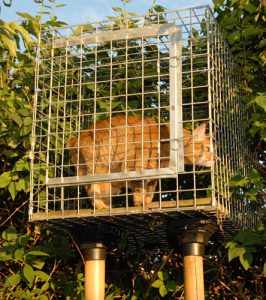
Domestic felines can disrupt ecosystem
Housecats are leaving an indelible imprint on Toronto’s ecosystem, but it’s not a purrfect one.
Kicking off its Keep Animals Safe campaign in the Beach, the Toronto Wildlife Centre is educating the public on the damage domestic cats cause in the great outdoors.
“Say, for example, you have a neighbourhood with a bunch of outdoor cats and those cats are preying on a certain type of sparrow,” said Erin Luther, education project coordinator for the centre. “In a wild ecosystem, once the population level of that sparrow goes down, the predators start being affected as well.
“So if there weren’t enough sparrows for the predators, they would start to die off, too.”
It’s Toronto Wildlife’s first venture into the public education spotlight and its hope is to illustrate just how fragile the city’s ecosystem is.
“Cats just are not a part of natural ecosystems at all, so prey species have not adapted to have defences against them,” Luther said. “They can’t defend themselves. And cats themselves, because they’re sustained by people, are kept at really unnatural levels.”
Those meowing about keeping their cats indoors 24/7 do have another option: enclosures.
Kristine Kischer, a former prop designer for the National Ballet of Canada, has built a business on giving kitties their outside time without allowing them to run free through the neighbourhood.
Her company, Habitat Haven, builds sturdy, outdoor pads for pets that attach to pet owners’ homes.
“It keeps cats away from the wildlife so you won’t have the baby birds being maimed,” she said.
Kischer connected with Toronto Wildlife by donating a cat enclosure every year to the centre’s annual ball.
Made from metal and wood, the enclosures include flexible tunnels that can bend around trees and buildings. Felines can come and go as they please through a cat door placed in a window of the house.
“All we do is put a Plexiglas sleeve with a cat door where the screen normally is — so again your window is not damaged in any degree — and when you don’t want the cats to go out, you just close your window,” Kischer said.
It’s not just for cats, either. Some clients use them for dogs, tortoises and rabbits. Kischer said it could have saved the life of a chihuahua that was attacked by the now infamous Neville Park coyote.
Though Luther said the wily canine is not what provoked the centre’s campaign, there’s still plenty to caterwaul about pet safety.
A recent study out of Arizona noted 42 percent of coyotes’ diets were housecats, Luther said.
“That’s a bit high: other cities have found numbers of 13 percent,” she said. “But even for one study to find that high of a level is certainly a reason for concern.”
